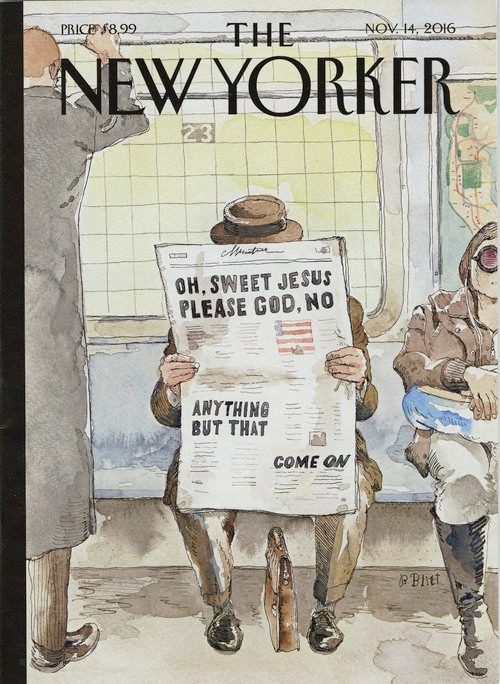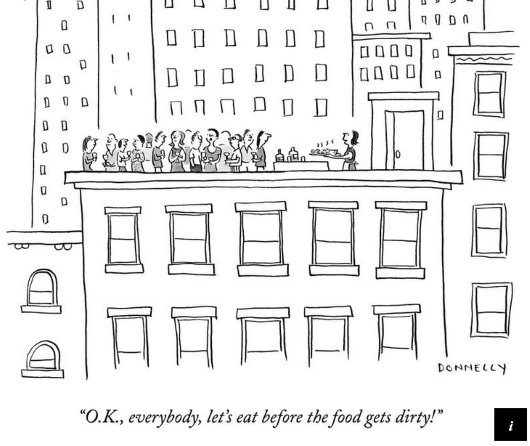Mag & Gag Cartoonists in News
Skip to commentsLiana Finck on parenting, patriarchy + brevity
What is your process for writing a cartoon? How many drafts does it take to get to the perfect, pithy final? Do you think there’s some inherent brilliance in brevity?
I do think there’s an inherent brilliance in brevity. That said, my cartoons tend to be better when I have time to go through a number of drafts. I don’t always, but I pay for it when I don’t.

Jess Mack at Birdseed interviews cartoonist/illustrator Linda Finck.
Liana Finck is writer, illustrator, thinker, and parental unit. You’re likely familiar with her brilliant and droll cartoons which strike a bullseye into our complicated states of being human. I have thoroughly enjoyed Liana’s work for some time because it often occupies my favorite life venn diagram, which is amusing-overlapping-melancholy. She has a new children’s book out, Mixed Feelings, which my husband declared the best book on feelings he’s ever read. It really is wonderful for adults + kids alike. Subscribe to her lovely Substack here.
Barry Blitt reflects on the art of finding a laugh
It is thrilling to do a New Yorker cover …It’s still nerve-wracking to get the call and exciting to go ahead and finish it… As far as seeing it after its published I invariably regret visual decisions I’ve made.


above: a couple seemingly evergreen New Yorker covers of America by Barry Blitt
A 16 minute audio interview with cartoonist/illustrator Barry Blitt.
In cartooning and in life, Barry Blitt is looking for a laugh. For more than 30 years, the Canadian-American, Pulitzer Prize-winning artist’s illustrations have donned the covers and pages of The New Yorker. As the magazine marks its 100th anniversary, he joins Piya Chattopadhyay to talk about the challenges of political cartooning in a polarized political climate, and what it takes to find humour in the humourless.
100 Years of 100 Things: New Yorker Cartoons
Brian Lehrer: Do the cartoonists always do both the visual and the line? It’s not necessarily the same talent?
Liza Donnelly: No. We’re a weird breed, Brian. I think many of us do do both. I actually don’t know now if it’s most, but I think most of us do do both. It’s like a worldview coming from one person that’s looking at the world and finding something funny in it or something meaningful in it and sharing it with readers. Sometimes people use caption writers, they’re called gag writers, and they did that a lot of that in the ’30s and ’40s, and then in my generation, when I started the late ’70s, it became sort of a point of pride that you didn’t use a gag writer.

For WNYC Brian Lehrer interviews cartoonist/historian Liza Donnelly.
As our centennial series continues, Liza Donnelly, writer and cartoonist at The New Yorker and the author of Very Funny Ladies: The New Yorker’s Women Cartoonists, 1925-2021 (Prometheus, 2022) and the Substack “Seeing Things“, talks about the evolution of the “New Yorker cartoon” now on display in an exhibit at the Society of Illustrators.
=>See Drawn From The New Yorker: A Centennial Celebration curated by Liza Donnelly at The Society of Illustrators, 128 East 63rd Street, through May 3.=>To see the cartoons, check out the slideshows here:
https://societyillustrators.org/event/the-history-of-the-new-yorker-a-conversation-with-liza-donnelly-and-michael-maslin/ https://societyillustrators.org/event/drawn-from-the-new-yorker-a-centennial-celebration/
https://www.newyorker.com/gallery/a-centenary-cartoon-collection
How do you win The New Yorker’s caption contest?
Western North Carolina is full of artists, writers, and creative minds — and, as it turns out, at least one New Yorker Cartoon Caption Contest winner.

The New Yorker recently celebrated its 100th birthday. The magazine is known for long-form reporting, fiction, poetry, reviews — and, of course, cartoons. One of its “newer traditions,” started in 1998, invites readers to write the perfect caption for a cartoon. Thousands enter each week, but only a select few win.
When BPR asked listeners if anyone had ever won, an email came in: “My husband did.”
Helen Chickering for WFAE Charlotte carries the story of local man who won the grand prize.
Roth’s background in TV and film had taught him how to build a story with dialogue and scenes. But writing a caption? That meant tinkering with every word — until the right one finally landed.
“There was some pondering involved for sure,” he says. “And also, the wordsmithing was, from the feedback I’ve gotten, critical. And then, all of a sudden, you get hit by the thunderbolt or whatever, and yeah, that was it.”
Yeah, it seems that The New Yorker is the last magazine standing as far as cartoons are concerned, though Ron Coleman can point out scores of magazines that still buy and publish gag cartoons. But the days of Esquire, Playboy, Collier’s, Saturday Evening Post, etc are gone. Though the SatEvePost still revels in the “good ‘ol days.”
Saturday Evening Post Cartoon Collections

The Saturday Evening Post’s weekly cartoon revue.


Comments 2
Comments are closed.